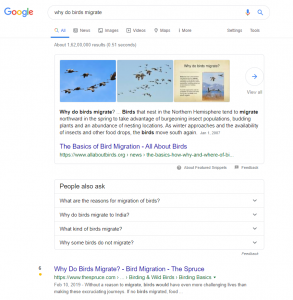Google’s Featured Snippet DeDuplication Update

- 11% of search results have featured snippets
- 70% of featured snippets did not come from the first organic search result
- Keywords with featured snippets are taking 8.6% of all clicks
What Does the Update Do?
When the featured snippet was first introduced by Google in 2014, it changed the game for search engine optimization. Having a position above the highest-ranking organic results meant you were winning the SEO battle without needing that coveted #1 ranking.
Especially true — you could get a better ranking — if the featured snippet came from a site which also ranked on the first page of Google search results. You weren’t only securing traffic from your Google ranking; you were also guaranteeing that your content would be the first thing anyone would see for that particular query. Talk about a double whammy.
But, gone are those days to the dismay of marketers and businesses alike. Google’s latest de-duplication update makes it so that if a URL is chosen as the featured snippet, that URL is removed from the first page of Google results.
Update Overview
You’ve got the general idea of what the update is intended to do, but that’s not all. Here are some additional notes to keep in mind as you read:
- Featured snippet duplicate URL change is being called deduplication
- Deduplication is being enacted globally
- Deduplication affects even featured snippet variants that resemble a knowledge panel
- Deduplication does not affect top stories
- Deduplication does not affect Interesting Finds
- There will be no change in Google Search Console (GSC) performance reports.
- Deduplication does not affect the URL for images featured on a snippet because images do not have a search listing.
We will explore the nuance of the update and the implications for your search engine optimization strategy but first things first…
What is a Featured Snippet?
Featured Snippets are often referred to as ‘Rank Zero’ because they are visible above any of the organic search results found on the first page. The snippet itself is more or less what it sounds like – a cut-out of information from a URL that the Google algorithm thinks answers your particular search query most accurately, the purpose is to make what you’re seeking easily discoverable and save you time.
An example would be if you wanted to search for “Why do birds migrate?” Your Google results page would look something like this:

You’ll notice a couple of things on this sample Google page.
- Right below the search bar, there’s a box that contains what Google believes is the answer to your question, that is your featured snippet.
- The snippet includes the title of the article in which the answer was found and the URL for the website.
- The URL on the featured snippet is not the same as the first result of the page – we will get to this in a bit.
There are three main types of snippets which vary depending on the query:
- Paragraph
- List
- Table
By far, the most common variation is the paragraph. It occupies over 80% of the featured snippets, with lists and tables appearing on 10% and 7% of searches respectively.
The Reason for the Change
Google’s goal is to bring its users the most accurate results for their inquiries. Part of this process involves pruning the hits on the search engine results pages (SERPs) so that users don’t have to sift through duplicates.
The featured snippet deduplication update causes the URL found on the featured snippet to be moved to the second page of Google results, usually ranking eleven overall (rank #1 of page two). However, do keep in mind that this is not necessarily guaranteed, but it does seem to be the case for a large number of websites. This example serves to curve duplicate results while increasing the accuracy of individual search results.
Why Are People Freaking Out?
Some cursory research into this topic will find you many a blog post expressing concern with this update. The handwringing is due to the feared effect on internet marketing at large and the SEO industry specifically. Several respected members of the SEO community have already seen traffic to their client’s websites decrease by as much as 30%. I know that sounds like a lot, but the numbers don’t paint the full picture.
Consider how you use search, yourself. If you’ve come across a snippet, did you actually click on the link or simply skim the eight bullet points or synopsis without clicking through? Here is some information on keyword research, also.
Internet marketing agencies have made it part of their strategy to reach that coveted snippet section since Google rolled out the feature. Many were successful, and along with a comprehensive SEO strategy, they managed to get their client pages on the first page of search results and snatch that featured snippet spot as well.
Now that Google will only allow one unique URL on the first page of results (including the featured snippet), a lot of those sites have seen a reduction in traffic.
They are still experiencing the benefit of being on the first page, but now users are less likely to click on their link because there are simply fewer of them.
What This Means for Your SEO Strategy
Right now, we are still in the ‘wait-and-see’ stage, and it’s probably unwise to rush to de-optimize until more data has been analyzed. The best advice in this scenario is to examine your results before making a decision.
If your website happened to be ranked at number one and your content was also in the featured snippet, then you likely suffered a loss of traffic because 8.6% of all clicks came from snippets while 19.6% came from the organic search result ranking at one. In this case, your website would be removed from the first page of Google results, potentially costing your nearly 20% of clicks.
However, in circumstances in which a website ranked low on the first page of results, pursuing the featured snippet spot is still very much viable.
Why You’ll Probably Be Just Fine
The general consensus among SEO experts seems to be that client portfolios have remained stable overall. The reason for this is that unless you were already ranking #1 on Google search results and also had secured a position on the featured snippet section, you were still able to enjoy the traffic benefits with minimal change. This was likely the case for most URLs since 70% of snippets came from websites outside of the first overall organic position.
What Do I Do Now?
The repercussions of this change are yet to be fully understood. Currently, the effects seem to be marginal for the majority of users. As frustrating as it can be right out of the gate, patience is key. In the interim, it’s best to practice some sound SEO strategies to maintain your level of effectiveness.
Internet marketing — especially when SEO is involved — is a marathon, not a sprint. The best way to combat changes like those routinely enacted by search engines like Google is to have a multi-channel, integrated marketing plan, that focuses on quality content and serves your customer’s needs. If you have heard that before, it’s because it works.
Sit tight, practice sensible SEO strategies, build a strong marketing campaign for your product and brand, and you will outlast any other digital storm that might be brewing at the Google headquarters.
The post Google’s Featured Snippet DeDuplication Update appeared first on ReadWrite.
(158)